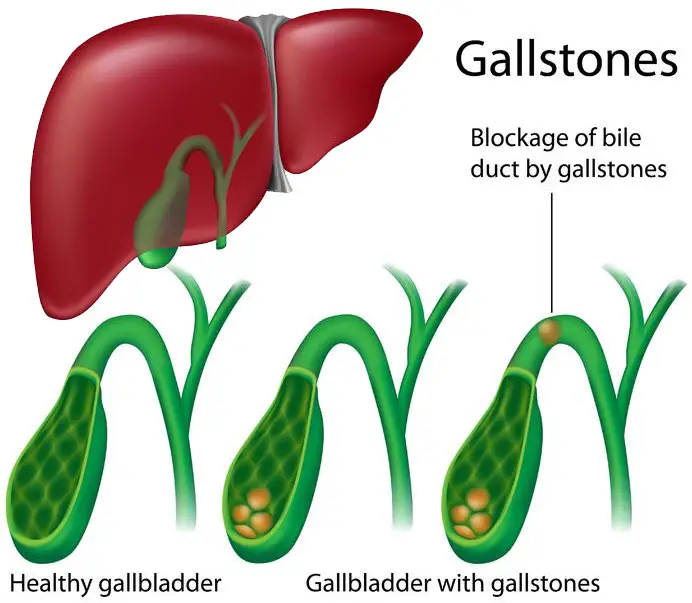
The good news is that gallstones are actually easily treated. While cutting out the gall bladder is the most common option, there are some effective alternatives to surgery, including a natural treatment to flush your gallstones naturally and painlessly. This is almost always a better option for those suffering from gallstones.
- Check out this comprehensive guide on getting rid of your gallstones naturally.
Just what is the gallbladder?
Before you decide on surgery for your gallstones treatment, you might want to know what function the gallbladder has in your body. The gallbladder is part of the body’s means of digesting food, and is part of a group of organs called the biliary tract.
The biliary tract begins at the liver, which is responsible for the production of bile. Bile is a substance that is made up of phospholipids and bile salts.
Bile’s function is to break down fats that are eaten, making them either useable by the body or easy to eliminate. This substance is also the main way that the body eliminates cholesterol and excess bilirubin (the waste from old blood cells) from the body.
As bile leaves the liver, much of it goes to the gallbladder where it is concentrated and stored.
When the stomach empties its contents into the upper part of the intestines (called the duodenum), the gallbladder empties its store of bile into ducts that transfer the bile to the duodenum.
There, the bile aids the digestion of dietary fats. In short, the gallbladder is vital for digestion of fats through the storage and release of bile.
Can I live without it?
The easy answer is yes, people can live normal without the gallbladder, relatively healthy lives without their gallbladders.
However, some people experience complications of gallbladder removal, which may include diarrhea or constant indigestion due to poor absorption of dietary fats.
What are gallstones?
Understanding what gallstones are is actually a great way to make better decisions about treatment. Many people have gallstones without ever having any symptoms. If, however, you are one of those who are facing pain as a result of gallstones, you will want to take steps to get rid of them.
Gallstones are not really stones in the true sense of the word, but are small, hardened collections of either cholesterol or dark pigments. For this reason, gallstones can be classified into three main groups:
- Cholesterol stones – are made up of excess cholesterol.
- Black pigment stones – are made up of excessive bilirubin (old red blood cells) that the liver breaks downfrom the blood.
- Brown pigment stones – are made up of bile sediment, usually due to infection or slow flow of bile.
What causes gallstones?
Medical science has yet to pinpoint the exact cause of gallstones. What is known is that there are a number of factors that have been connected to gallstone formation. The causes of pigment gallstones are not really known, but may be related to liver disease, infection of the biliary tract, or sickle cell anemia.

Causes for cholesterol stones may include:
- High fat/Low fiber Diets – the typical American diet is thought to be a major cause in gallstone formation, with its high fat and cholesterol content and low amounts of quality fiber.
- Obesity – clinical studies show a direct correlation between obesity and gallstone formation. Higher body mass index produces higher risk of stone formation.
- Rapid Weight Loss – an interesting twist on gallstone formation is the link with rapid weight loss, especially when it is due to weight-loss surgery such as a gastric bypass. This is because the sudden loss of weight puts cholesterol that was stored in the fat back into the bloodstream.
While these are some of the major causes of cholesterol stones, other factors may contribute, including:
- Diabetes
- Age
- Gender
- Ethnicity
Surgical Treatment
If your doctor has diagnosed you gallstones, he will probably recommend surgical removal of the gallbladder. This is called a cholecystectomy. There are two main types of gallbladder removal surgeries:
- Abdominal Incision – the traditional type of surgery involves a large incision in the abdomen. It involves a longer recovery time, and more associated pain.
- Laparoscopic Surgery – is usually done through two small incisions in the abdomen. A small camera is inserted through one opening, while the actual removal is done through the other. This type of surgery has a much shorter recovery time.
Most people recover well from cholecystectomy, but some have recurring symptoms, or may face ongoing complications. Most of the complications are due to the bile flowing continually into the intestines, rather than being stored and released by the gallbladder.
Alternative Treatments
There are a number of alternatives to surgical treatment. Care should be taken before using any alternative therapy, as acute cases of an inflamed gallbladder may need immediate attention. However, in many cases people find that their condition allows time for pursuing alternative therapies. Look for other reasons for stomach pain after eating as well, as there may be other reasons.
If you can wait to pursue alternative methods, the advantages include avoiding the whole surgical procedure with the anesthesia related risks, as well as avoiding the possible complications of living without a gallbladder.
- Dietary Change – One of the first steps in dealing with gallstone disease is immediate change to the diet. Quickly eliminate excess fats, and avoid all trans fatty acids. Look for healthier fat alternatives such as olive oil, as well as lower-fat options in the dairy section. Fried foods should be eliminated, and trimmed chicken or fish should be the main meat sources. Including plenty of high fiber foods such as vegetables and whole grains such as brown rice, is another important step. Because sugar is thought to contribute to gallstone formation, limiting sugar intake as well as carbohydrates should be considered.
- Herbal Therapy – a number of herbs have been shown to help support normal gallbladder function. These include milk thistle and globe artichoke. Standardized extracts of these herbs are usually recommended, since this will assure uniform dosage. Both of these herbs work to detoxify the liver and gallbladder. Rosemary is another herb to consider, as it aids the digestion of fats, stimulates bile production, and may help eliminate spasms in the gallbladder.
- Gallbladder Flush – an alternative therapy that has found great success, a gallbladder cleanse works by breaking down the stones and flushing them out of the body. These are usually done with simple ingredients, and can be very effective. Before beginning a gallbladder flush, you will want to choose a proven method, rather than just follow a quick suggestion found on the internet. In addition, it is important to realize that smaller, cholesterol-based stones respond better to this treatment. If your ultrasound revealed a large gallstone, a flush may not be successful.
Although your physician may not provide information on alternative treatments for gallstones, many people have found safe, effective results with natural therapies.
If it is possible to avoid removal of your gallbladder while still dealing with the gallstones, you may have a healthier digestive tract and experience fewer negative side-effects.


Leave a Reply